Pb(II) Uptake from Polluted Irrigation Water Using Anatase TiO2 Nanoadsorbent
Abstract
1. Introduction
2. Results and Discussions
2.1. Characterization of Nano-TiO2
2.1.1. XRD and Rietveld Analysis
2.1.2. SEM and EDS Mapping Analysis
2.1.3. TEM Analysis
2.1.4. XPS Analysis
2.2. Adsorption Kinetics
| Adsorbent | Adsorption Capacity qm (mg g−1) | pH | Time (h) | Dose (g L−1) | Ci (mg L−1) | Reference |
|---|---|---|---|---|---|---|
| nano-TiO2 | 32.03 | 8 | 2 | 0.01 | 0.1 | [43] |
| nano-TiO2 | 7.41 | 6 | 4 | 4 | 25 | [39] |
| nano-TiO2 | 158.73 | 7 | 24 | 0.32 | 100 | [40] |
| Anatase | 194.28 | 7 | 0.25 | 400 | [42] | |
| Titania nanofiber | 2.56 | 5 | 4 | 0.05 | 0.50 | [44] |
| Composed of pectin and nano-TiO2 | 66.28 | 5.5 | 1 | 3 | 95.83 | [4] |
| Graphene oxide and TiO2 nanocomposite | 65.6 | 5.6 | 12 | 0.025 | 50 | [45] |
| Graphene oxide nanocomposite | 35.6 | 5.6 | 6 | 0.025 | 50 | [45] |
| nano-ZnO | 6.7 | 6.6 | 72 | 1 | 1010 | [46] |
| nano-CeO2 | 9.2 | 7 | NR | 2 | NR | [47] |
| Modified nano-Al2O3 | 100 | 5 | 1.5 | 1 | 50 | [48] |
| Kaolinite | 7.75 | 4.5 | 48 | 0.1 | 2000 | [49] |
| Montmorillonite | 31.10 | 5.7 | 3 | 2 | 50 | [50] |
| Bentonite | 51.19 | NR | 3 | 20 | 200 | [51] |
| Biomass of A. bisporus | 33.78 | 5.0 | 4 | 3 | 100 | [52] |
| Biomass of Aspergillus niger | 32.60 | 4.0 | 2 | 1 | 100 | [53] |
| Anaerobic granular biomass | 255.00 | 4.0–5.5 | 0.5 | 10 | 100 | [54] |
| nano-TiO2 | 65.99 | 6.5 | 1 | 1 | 47.54 | This work. |
2.3. Effect of pH
2.4. Adsorbent Dose
2.5. Adsorption Isotherms
2.6. Adsorption Mechanisms of Pb(II) on TiO2
3. Perspectives
4. Materials and Methods
4.1. Materials and Chemicals
4.2. Characterization of Nano-TiO2
4.2.1. X-ray Diffraction (XRD)
4.2.2. Scanning Electron Microscopy (SEM), Energy Dispersive Spectroscopy (EDS), and Transmission Electron Microscopy (TEM)
4.2.3. X-ray Photoelectron Spectroscopy (XPS)
4.3. Pb(II) Removal Experiments with Nano-TiO2
4.3.1. Adsorption Kinetics
4.3.2. pH Effect
4.3.3. Adsorbent Dose
4.3.4. Adsorption Isotherms
5. Conclusions
Supplementary Materials
Author Contributions
Funding
Data Availability Statement
Acknowledgments
Conflicts of Interest
Sample Availability
References
- Lu, F.; Astruc, D. Nanomaterials for removal of toxic elements from water. Coord. Chem. Rev. 2018, 356, 147–164. [Google Scholar] [CrossRef]
- Baruah, S.; Najam Khan, M.; Dutta, J. Perspectives and applications of nanotechnology in water treatment. Environ. Chem. Lett. 2016, 14, 1–14. [Google Scholar] [CrossRef]
- World Water Development Report 2018|UN-Water. Available online: https://www.unwater.org/publications/world-water-development-report-2018 (accessed on 19 March 2023).
- Bok-Badura, J.; Jakóbik-Kolon, A.; Karoń, K.; Mitko, K. Sorption studies of heavy metal ions on pectin-nano-titanium dioxide composite adsorbent. Sep. Sci. Technol. 2018, 53, 1034–1044. [Google Scholar] [CrossRef]
- Bhatia, M.; Satish Babu, R.; Sonawane, S.H.; Gogate, P.R.; Girdhar, A.; Reddy, E.R.; Pola, M. Application of nanoadsorbents for removal of lead from water. Int. J. Environ. Sci. Technol. 2017, 14, 1135–1154. [Google Scholar] [CrossRef]
- Jyothi, B.; Singa, P.M.; Desai, N.N. Performance of TiO2 Nano powder in Removal of Lead from Synthetic Solution. Int. Res. J. Eng. Technol. 2015, 2, 1396–1399. [Google Scholar]
- Sepehri, S.; Kanani, E.; Abdoli, S.; Rajput, V.D.; Minkina, T.; Asgari Lajayer, B. Pb(II) Removal from Aqueous Solutions by Adsorption on Stabilized Zero-Valent Iron Nanoparticles—A Green Approach. Water 2023, 15, 222. [Google Scholar] [CrossRef]
- Chanthapon, N.; Sarkar, S.; Kidkhunthod, P.; Padungthon, S. Lead removal by a reusable gel cation exchange resin containing nano-scale zero valent iron. Chem. Eng. J. 2018, 331, 545–555. [Google Scholar] [CrossRef]
- Wang, C.; Wang, H.; Cao, Y. Pb(II) sorption by biochar derived from Cinnamomum camphora and its improvement with ultrasound-assisted alkali activation. Colloids Surf. A Physicochem. Eng. Asp. 2018, 556, 177–184. [Google Scholar] [CrossRef]
- Moustafa, H.; Isawi, H.; Abd El Wahab, S.M. Utilization of PVA nano-membrane based synthesized magnetic GO-Ni-Fe2O4 nanoparticles for removal of heavy metals from water resources. Environ. Nanotechnol. Monit. Manag. 2022, 18, 100696. [Google Scholar] [CrossRef]
- World Health Organization. Guidelines for Drinking-Water Quality; World Health Organization: Geneva, Switzerland, 2011; ISBN 9789241548151. [Google Scholar]
- Long, Y.; Jiang, J.; Hu, J.; Hu, X.; Yang, Q.; Zhou, S. Removal of Pb(II) from aqueous solution by hydroxyapatite/carbon composite: Preparation and adsorption behavior. Colloids Surf. A Physicochem. Eng. Asp. 2019, 577, 471–479. [Google Scholar] [CrossRef]
- Van Tran, C.; Quang, D.V.; Nguyen Thi, H.P.; Truong, T.N.; La, D.D. Effective Removal of Pb(II) from Aqueous Media by a New Design of Cu-Mg Binary Ferrite. ACS Omega 2020, 5, 7298–7306. [Google Scholar] [CrossRef] [PubMed]
- Wang, Y.Y.; Liu, Y.X.; Lu, H.H.; Yang, R.Q.; Yang, S.M. Competitive adsorption of Pb(II), Cu(II), and Zn(II) ions onto hydroxyapatite-biochar nanocomposite in aqueous solutions. J. Solid State Chem. 2018, 261, 53–61. [Google Scholar] [CrossRef]
- Carolin, C.F.; Kumar, P.S.; Saravanan, A.; Joshiba, G.J.; Naushad, M. Efficient techniques for the removal of toxic heavy metals from aquatic environment: A review. J. Environ. Chem. Eng. 2017, 5, 2782–2799. [Google Scholar] [CrossRef]
- Azimi, A.; Azari, A.; Rezakazemi, M.; Ansarpour, M. Removal of Heavy Metals from Industrial Wastewaters: A Review. Chem. Bio. Eng. Rev. 2017, 4, 37–59. [Google Scholar] [CrossRef]
- Bolisetty, S.; Peydayesh, M.; Mezzenga, R. Sustainable technologies for water purification from heavy metals: Review and analysis. Chem. Soc. Rev. 2019, 48, 463–487. [Google Scholar] [CrossRef] [PubMed]
- Lata, S.; Singh, P.K.; Samadder, S.R. Regeneration of adsorbents and recovery of heavy metals: A review. Int. J. Environ. Sci. Technol. 2015, 12, 1461–1478. [Google Scholar] [CrossRef]
- Santhosh, C.; Velmurugan, V.; Jacob, G.; Jeong, S.K.; Grace, A.N.; Bhatnagar, A. Role of nanomaterials in water treatment applications: A review. Chem. Eng. J. 2016, 306, 1116–1137. [Google Scholar] [CrossRef]
- Hashem, M.; Al-Karagoly, H. Synthesis, characterization, and cytotoxicity of titanium dioxide nanoparticles and in vitro study of its impact on lead concentrations in bovine blood and milk. J. Biotech Res. 2021, 12, 93–105. [Google Scholar]
- Motlochová, M.; Slovák, V.; Pližingrová, E.; Lidin, S.; Šubrt, J. Highly-efficient removal of Pb(II), Cu(II) and Cd(II) from water by novel lithium, sodium and potassium titanate reusable microrods. RSC Adv. 2020, 10, 3694–3704. [Google Scholar] [CrossRef]
- Govan, J. Recent advances in magnetic nanoparticles and nanocomposites for the remediation of water resources. Magnetochemistry 2020, 6, 49. [Google Scholar] [CrossRef]
- Hornyak, G.L. Introduction to Nanoscience and Nanotechnology; CRC Press: Boca Raton, FL, USA, 2008; ISBN 9781420048056. [Google Scholar]
- Zhu, Y.; Liu, X.; Hu, Y.; Wang, R.; Chen, M.; Wu, J.; Wang, Y.; Kang, S.; Sun, Y.; Zhu, M. Behavior, remediation effect and toxicity of nanomaterials in water environments. Environ. Res. 2019, 174, 54–60. [Google Scholar] [CrossRef]
- George, R.; Bahadur, N.; Singh, N.; Singh, R.; Verma, A.; Shukla, A.K. Environmentally Benign TiO2 Nanomaterials for Removal of Heavy Metal Ions with Interfering Ions Present in Tap Water. Mater. Today Proc. 2016, 3, 162–166. [Google Scholar] [CrossRef]
- Song, H.; Kuang, X.; Wei, X.; Luo, S.; Zeng, Q.; Peng, L. The effect of TiO2 nanoparticles size on Cd (II) removal by the paddy crusts from waterbody. J. Environ. Chem. Eng. 2022, 10, 107883. [Google Scholar] [CrossRef]
- Giammar, D.E.; Maus, C.J.; Xie, L. Effects of particle size and crystalline phase on lead adsorption to titanium dioxide nanoparticles. Environ. Eng. Sci. 2007, 24, 85–95. [Google Scholar] [CrossRef]
- Prasai, B.; Cai, B.; Underwood, M.K.; Lewis, J.P.; Drabold, D.A. Properties of amorphous and crystalline titanium dioxide from first principles. J. Mater. Sci. 2012, 47, 7515–7521. [Google Scholar] [CrossRef]
- Custodio, M.; Álvarez, D.; Cuadrado, W.; Montalvo, R.; Ochoa, S. Potentially toxic metals and metalloids in surface water intended for human consumption and other uses in the Mantaro River watershed, Peru. Soil Water Res. 2020, 15, 237–245. [Google Scholar] [CrossRef]
- Popa, N.C. The (hkl) dependence of diffraction-line broadening caused by strain and size for all laue groups in rietveld refinement. J. Appl. Crystallogr. 1998, 31, 176–180. [Google Scholar] [CrossRef]
- Canchanya-Huaman, Y.; Mayta-Armas, A.F.; Pomalaya-Velasco, J.; Bendezú-Roca, Y.; Guerra, J.A.; Ramos-Guivar, J.A. Strain and grain size determination of CeO2 and TiO2 nanoparticles: Comparing integral breadth methods versus Rietveld, µ-Raman, and TEM. Nanomaterials 2021, 11, 2311. [Google Scholar] [CrossRef]
- Patidar, V.; Jain, P. Green Synthesis of TiO2 Nanoparticle Using Moringa Oleifera Leaf Extract. Int. Res. J. Eng. Technol. 2017, 4, 470–473. [Google Scholar]
- Thamaphat, K.; Limsuwan, P.; Ngotawornchai, B. Phase Characterization of TiO2 Powder by XRD and TEM. Nat. Sci. 2008, 42, 357–361. [Google Scholar]
- Zhang, S.; Shi, Q.; Chou, T.M.; Christodoulatos, C.; Korfiatis, G.P.; Meng, X. Mechanistic study of Pb(II) removal by TiO2 and effect of PO4. Langmuir 2020, 36, 13918–13927. [Google Scholar] [CrossRef]
- Dementjev, A.P.; Ivanova, O.P.; Vasilyev, L.A.; Naumkin, A.V.; Nemirovsky, D.M.; Shalaev, D.Y. Altered layer as sensitive initial chemical state indicator. J. Vac. Sci. Technol. A Vac. Surf. Film. 1994, 12, 423–427. [Google Scholar] [CrossRef]
- Lu, C.J.; Kuang, A.X.; Huang, G.Y. X-ray photoelectron spectroscopy study on composition and structure of sol-gel derived PbTiO3 thin films. J. Appl. Phys. 1996, 80, 202–206. [Google Scholar] [CrossRef]
- Moulder, J.F.; Stickle, W.F.; Sobol, P.E.; Bomben, K.D. Handbook of X-ray Photoelectron Spectroscopy: A Reference Book of Standard Spectra for Identification and Interpretation of XPS Data; Perkin-Elmer Corporation: Waltham, MA, USA, 1992. [Google Scholar]
- Beamson, G.; Briggs, D. High Resolution XPS of Organic Polymers: The Scienta ESCA300 Database. J. Chem. Educ. 1993, 70, 778. [Google Scholar] [CrossRef]
- Poursani, A.S.; Nilchi, A.; Hassani, A. The synthesis of nano TiO2 and its use for removal of lead ions from aqueous solution. J. Water Resour. Prot. 2016, 08, 438–448. [Google Scholar] [CrossRef]
- Recillas, S.; García, A.; González, E.; Casals, E.; Puntes, V.; Sánchez, A.; Font, X. Use of CeO2, TiO2 and Fe3O4 nanoparticles for the removal of lead from water. Toxicity of nanoparticles and derived compounds. Desalination 2011, 277, 213–220. [Google Scholar] [CrossRef]
- Inquil Ayquipa, L.; Valverde Flores, J. Adsorption of lead and iron present in the waters of the Santa River using titanium dioxide nanoparticles (TiO2). J. Nanotechnol. 2020, 4, 8–10. [Google Scholar] [CrossRef]
- Kanna, M.; Wongnawa, S.; Sherdshoopongse, P. Adsorption behavior of some metal ions on hydrated amorphous titanium dioxide surface. Songklanakarin J. Sci. Technol. 2005, 27, 1017–1026. [Google Scholar]
- Engates, K.E.; Shipley, H.J. Adsorption of Pb, Cd, Cu, Zn, and Ni to titanium dioxide nanoparticles: Effect of particle size, solid concentration, and exhaustion. Environ. Sci. Pollut. Res. 2011, 18, 386–395. [Google Scholar] [CrossRef]
- Dixit, A.; Mishra, P.K.; Alam, M.S. Titania Nanofibers: A Potential Adsorbent for Mercury and Lead Uptake. Int. J. Chem. Eng. Appl. 2017, 8, 75–81. [Google Scholar] [CrossRef]
- Lee, Y.C.; Yang, J.W. Self-assembled flower-like TiO2 on exfoliated graphite oxide for heavy metal removal. J. Ind. Eng. Chem. 2012, 18, 1178–1185. [Google Scholar] [CrossRef]
- Kikuchi, Y.; Qian, Q.; Machida, M.; Tatsumoto, H. Effect of ZnO loading to activated carbon on Pb(II) adsorption from aqueous solution. Carbon 2006, 44, 195–202. [Google Scholar] [CrossRef]
- Cao, C.Y.; Cui, Z.M.; Chen, C.Q.; Song, W.G.; Cai, W. Ceria hollow nanospheres produced by a template-free microwave-assisted hydrothermal method for heavy metal ion removal and catalysis. J. Phys. Chem. C 2010, 114, 9865–9870. [Google Scholar] [CrossRef]
- Afkhami, A.; Saber-Tehrani, M.; Bagheri, H. Simultaneous removal of heavy-metal ions in wastewater samples using nano-alumina modified with 2,4-dinitrophenylhydrazine. J. Hazard Mater. 2010, 181, 836–844. [Google Scholar] [CrossRef]
- Shahmohammadi-Kalalagh, S.; Babazadeh, H.; Manshouri, M. Isotherm and kinetic studies on adsorption of Pb, Zn and Cu by Kaolinite. Casp. J. Environ. Sci. 2010, 9, 243–255. [Google Scholar]
- Sen Gupta, S.; Bhattacharyya, K.G. Immobilization of Pb(II), Cd(II) and Ni(II) ions on kaolinite and montmorillonite surfaces from aqueous medium. J. Environ. Manag. 2008, 87, 46–58. [Google Scholar] [CrossRef] [PubMed]
- Al-Jlil, S.A. Kinetic study of adsorption of chromium and lead ions on bentonite clay using novel internal series model. Trends Appl. Sci. Res. 2015, 10, 38–53. [Google Scholar] [CrossRef]
- Vimala, R.; Das, N. Biosorption of cadmium (II) and lead (II) from aqueous solutions using mushrooms: A comparative study. J. Hazard Mater. 2009, 168, 376–382. [Google Scholar] [CrossRef]
- Dursun, A.Y. A comparative study on determination of the equilibrium, kinetic and thermodynamic parameters of biosorption of copper(II) and lead(II) ions onto pretreated Aspergillus niger. Biochem. Eng. J. 2006, 28, 187–195. [Google Scholar] [CrossRef]
- Hawari, A.H.; Mulligan, C.N. Biosorption of lead(II), cadmium(II), copper(II) and nickel(II) by anaerobic granular biomass. Bioresour. Technol. 2006, 97, 692–700. [Google Scholar] [CrossRef]
- Singh, S.; Barick, K.C.; Bahadur, D. Functional oxide nanomaterials and nanocomposites for the removal of heavy metals and dyes. Nanomater. Nanotechnol. 2013, 3, 3–20. [Google Scholar] [CrossRef]
- Hu, J.; Shipley, H.J. Regeneration of spent TiO2 nanoparticles for Pb (II), Cu(II), and Zn(II) removal. Environ. Sci. Pollut. Res. 2013, 20, 5125–5137. [Google Scholar] [CrossRef]
- López-Luna, J.; Ramírez-Montes, L.E.; Martinez-Vargas, S.; Martínez, A.I.; Mijangos-Ricardez, O.F.; González-Chávez, M.d.C.A.; Carrillo-González, R.; Solís-Domínguez, F.A.; Cuevas-Díaz, M.d.C.; Vázquez-Hipólito, V. Linear and nonlinear kinetic and isotherm adsorption models for arsenic removal by manganese ferrite nanoparticles. SN Appl. Sci. 2019, 1, 950. [Google Scholar] [CrossRef]
- Cao, Y.; Dong, S.; Dai, Z.; Zhu, L.; Xiao, T.; Zhang, X.; Yin, S.; Soltanian, M.R. Adsorption model identification for chromium(VI) transport in unconsolidated sediments. J. Hydrol. 2021, 598, 126228. [Google Scholar] [CrossRef]
- Zhao, X.; Jia, Q.; Song, N.; Zhou, W.; Li, Y. Adsorption of Pb(II) from an aqueous solution by titanium dioxide/carbon nanotube nanocomposites: Kinetics, thermodynamics, and isotherms. J. Chem. Eng. Data 2010, 55, 4428–4433. [Google Scholar] [CrossRef]
- Mostafa, N.G.; Yunnus, A.F.; Elawwad, A. Adsorption of Pb(II) from water onto ZnO, TiO2, and Al2O3: Process study, adsorption behaviour, and thermodynamics. Adsorpt. Sci. Technol. 2022, 2022, 7582756. [Google Scholar] [CrossRef]
- Shu, Y.; Huang, R.; Wei, X.; Liu, L.; Jia, Z. Pb(II) Removal using TiO2-Embedded Monolith Composite Cryogel as an alternative wastewater treatment method. Water Air Soil Pollut. 2017, 228, 375. [Google Scholar] [CrossRef]
- Karapinar, H.S.; Kilicel, F.; Ozel, F.; Sarilmaz, A. Fast and effective removal of Pb(II), Cu(II) and Ni(II) ions from aqueous solutions with TiO2 nanofibers: Synthesis, adsorption-desorption process and kinetic studies. Int. J. Environ. Anal. Chem. 2021, 103, 1–22. [Google Scholar] [CrossRef]
- Maleki, A.; Hayati, B.; Najafi, F.; Gharibi, F.; Joo, S.W. Heavy metal adsorption from industrial wastewater by PAMAM/TiO2 nanohybrid: Preparation, characterization and adsorption studies. J. Mol. Liq. 2016, 224, 95–104. [Google Scholar] [CrossRef]
- Tao, Y.; Ye, L.; Pan, J.; Wang, Y.; Tang, B. Removal of Pb(II) from aqueous solution on chitosan/TiO2 hybrid film. J. Hazard Mater. 2009, 161, 718–722. [Google Scholar] [CrossRef]
- Mendoza-Villa, F.; Checca-Huaman, N.R.; Ramos-Guivar, J.A. Ecotoxicological properties of titanium dioxide nanomorphologies in daphnia magna. Nanomaterials 2023, 13, 927. [Google Scholar] [CrossRef] [PubMed]
- Bhargavi, R.J.; Maheshwari, U.; Gupta, S. Synthesis and use of alumina nanoparticles as an adsorbent for the removal of Zn(II) and CBG dye from wastewater. Int. J. Ind. Chem. 2014, 6, 31–41. [Google Scholar] [CrossRef]
- Lima, E.C.; Sher, F.; Guleria, A.; Reza, M.; Anastopoulos, I.; Nguyen, H.; Hosseini-bandegharaei, A. Is One Performing the Treatment Data of Adsorption Kinetics Correctly? J. Environ. Chem. Eng. 2021, 9, 104813. [Google Scholar] [CrossRef]
- Ramos Guivar, J.A.; Bustamante, D.A.; Gonzalez, J.C.; Sanches, E.A.; Morales, M.A.; Raez, J.M.; López-Muñoz, M.J.; Arencibia, A. Adsorption of arsenite and arsenate on binary and ternary magnetic nanocomposites with high iron oxide content. Appl. Surf. Sci. 2018, 454, 87–100. [Google Scholar] [CrossRef]
- Razzaz, A.; Ghorban, S.; Hosayni, L.; Irani, M.; Aliabadi, M. Chitosan nanofibers functionalized by TiO2 nanoparticles for the removal of heavy metal ions. J. Taiwan Inst. Chem. Eng. 2016, 58, 333–343. [Google Scholar] [CrossRef]
- Chen, B.; Li, L.; Liu, L.; Cao, J. Molecular simulation of adsorption properties of thiol-functionalized titanium dioxide (TiO2) nanostructure for heavy metal ions removal from aqueous solution. J. Mol. Liq. 2022, 346, 118281. [Google Scholar] [CrossRef]
- Taty-Costodes, V.C.; Fauduet, H.; Porte, C.; Delacroix, A. Removal of Cd(II) and Pb(II) ions, from aqueous solutions, by adsorption onto sawdust of Pinus sylvestris. J. Hazard Mater. 2003, 105, 121–142. [Google Scholar] [CrossRef]
- Wang, D.; Wang, P.; Wang, C.; Ao, Y. Effects of interactions between humic acid and heavy metal ions on the aggregation of TiO2 nanoparticles in water environment. Environ. Pollut. 2019, 248, 834–844. [Google Scholar] [CrossRef]
- Ramirez, L.; Gentile, R.S.; Zimmerman, S.; Stoll, S. Behavior of TiO2 and CeO2 nanoparticles and polystyrene nanoplastics in bottled mineral, drinking and Lake Geneva Waters. Impact of water hardness and natural organic matter on nanoparticle surface properties and aggregation. Water 2019, 11, 721. [Google Scholar] [CrossRef]
- Spoială, A.; Ilie, C.-I.; Dolete, G.; Croitoru, A.-M.; Surdu, V.-A.; Trușcă, R.-D.; Motelica, L.; Oprea, O.-C.; Ficai, D.; Ficai, A.; et al. Preparation and characterization of chitosan/TiO2 composite membranes as adsorbent materials for water purification. Membranes 2022, 12, 804. [Google Scholar] [CrossRef]
- Ashraf, S.; Siddiqa, A.; Shahida, S.; Qaisar, S. Titanium-based nanocomposite materials for arsenic removal from water: A review. Heliyon 2019, 5, e01577. [Google Scholar] [CrossRef] [PubMed]
- Hu, J.; Shipley, H.J. Evaluation of desorption of Pb(II), Cu(II) and Zn(II) from titanium dioxide nanoparticles. Sci. Total Environ. 2012, 431, 209–220. [Google Scholar] [CrossRef] [PubMed]
- Perera, W.N.; Hefter, G.; Sipos, P.M. An investigation of the lead (II)-Hydroxide System. Inorg. Chem. 2001, 40, 3974–3978. [Google Scholar] [CrossRef] [PubMed]
- Ayers, R.S.; Westcot, D.W. Water Quality for Agriculture; Food and Agriculture Organization of the United Nations: Rome, Italy, 1985; ISBN 92-5-102263-1. [Google Scholar]
- Ho, Y.S. Citation review of Lagergren kinetic rate equation on adsorption reactions. Scientometrics 2004, 59, 171–177. [Google Scholar] [CrossRef]
- Tseng, R.L.; Wu, F.C.; Juang, R.S. Characteristics and applications of the Lagergren’s first-order equation for adsorption kinetics. J. Taiwan Inst. Chem. Eng. 2010, 41, 661–669. [Google Scholar] [CrossRef]
- Ho, Y.S.; McKay, G. Pseudo-second order model for sorption processes. Process Biochem. 1999, 34, 451–465. [Google Scholar] [CrossRef]
- Hamidpour, M.; Hosseini, N.; Mozafari, V.; Heshmati, M. Removal of Cd(II) and Pb(II) from aqueous solutions by pistachio hull waste. Rev. Int. de Contam. 2018, 34, 307–316. [Google Scholar] [CrossRef]
- Wu, F.C.; Tseng, R.L.; Juang, R.S. Characteristics of Elovich equation used for the analysis of adsorption kinetics in dye-chitosan systems. Chem. Eng. J. 2009, 150, 366–373. [Google Scholar] [CrossRef]
- Wang, J.; Guo, X. Rethinking of the Intraparticle Diffusion Adsorption Kinetics Model: Interpretation, Solving Methods and Applications. Chemosphere 2022, 309, 1–14. [Google Scholar] [CrossRef] [PubMed]
- Langmuir, I. The adsorption of gases on plane surfaces of glass, mica and platinum. J. Am. Chem. Soc. 1918, 40, 1361–1403. [Google Scholar] [CrossRef]
- Skopp, J. Derivation of the Freundlich Adsorption Isotherm from Kinetics. J. Chem. Educ. 2009, 86, 1341–1343. [Google Scholar] [CrossRef]
- Chu, K.H. Revisiting the Temkin Isotherm: Dimensional Inconsistency and Approximate Forms. Ind. Eng. Chem. Res. 2021, 60, 13140–13147. [Google Scholar] [CrossRef]
- Sips, R. On the structure of a catalyst surface. J. Chem. Phys. 1948, 16, 490–495. [Google Scholar] [CrossRef]
- Redlich, O.; Peterson, D.L. A useful adsorption isotherm. J. Phys. Chem. 1959, 63, 1024. [Google Scholar] [CrossRef]
- James, G.; Witten, D.; Hastie, T.; Tibshirani, R. An Introduction to Statistical Learning; Springer: New York, NY, USA, 2017. [Google Scholar] [CrossRef]


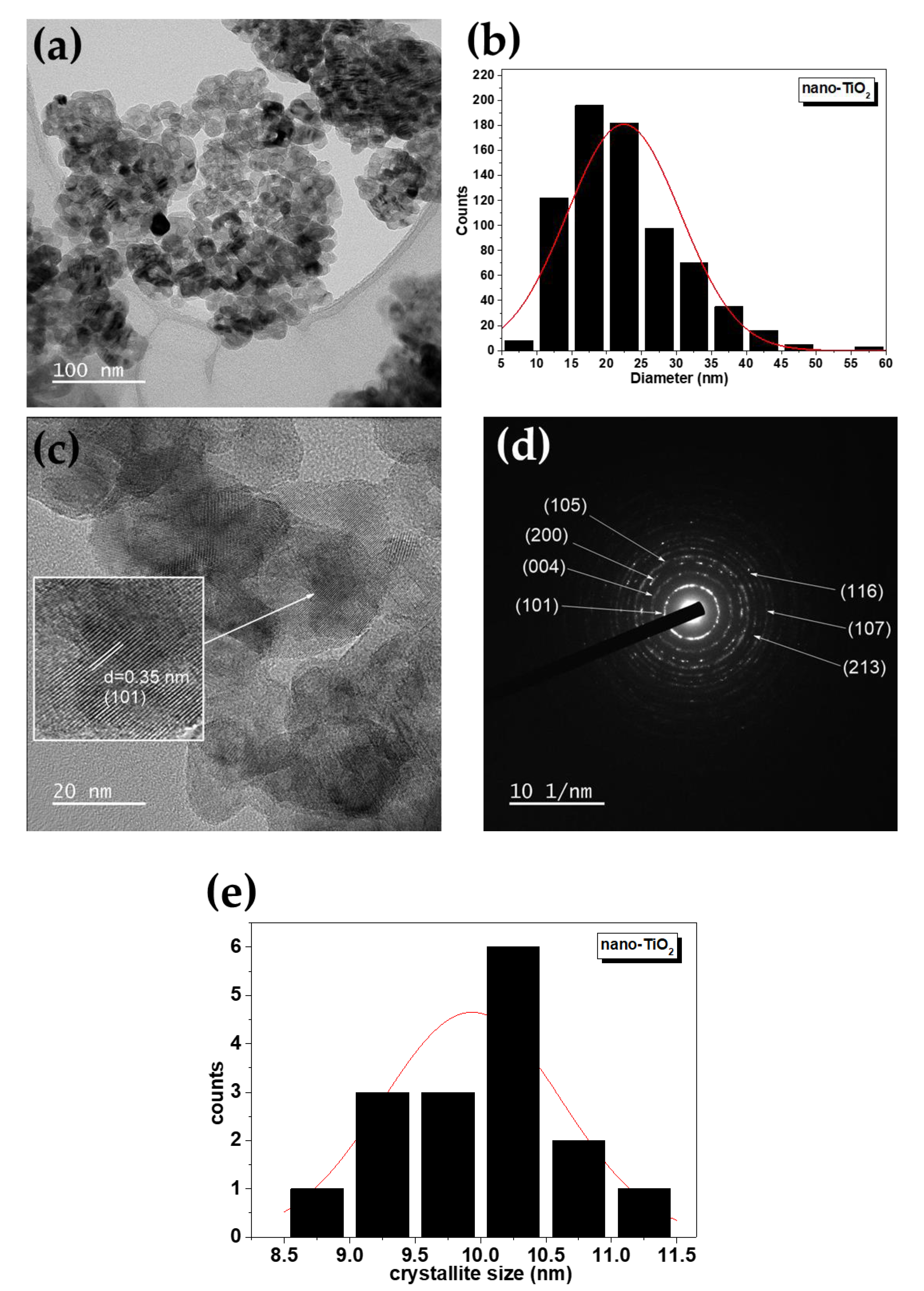
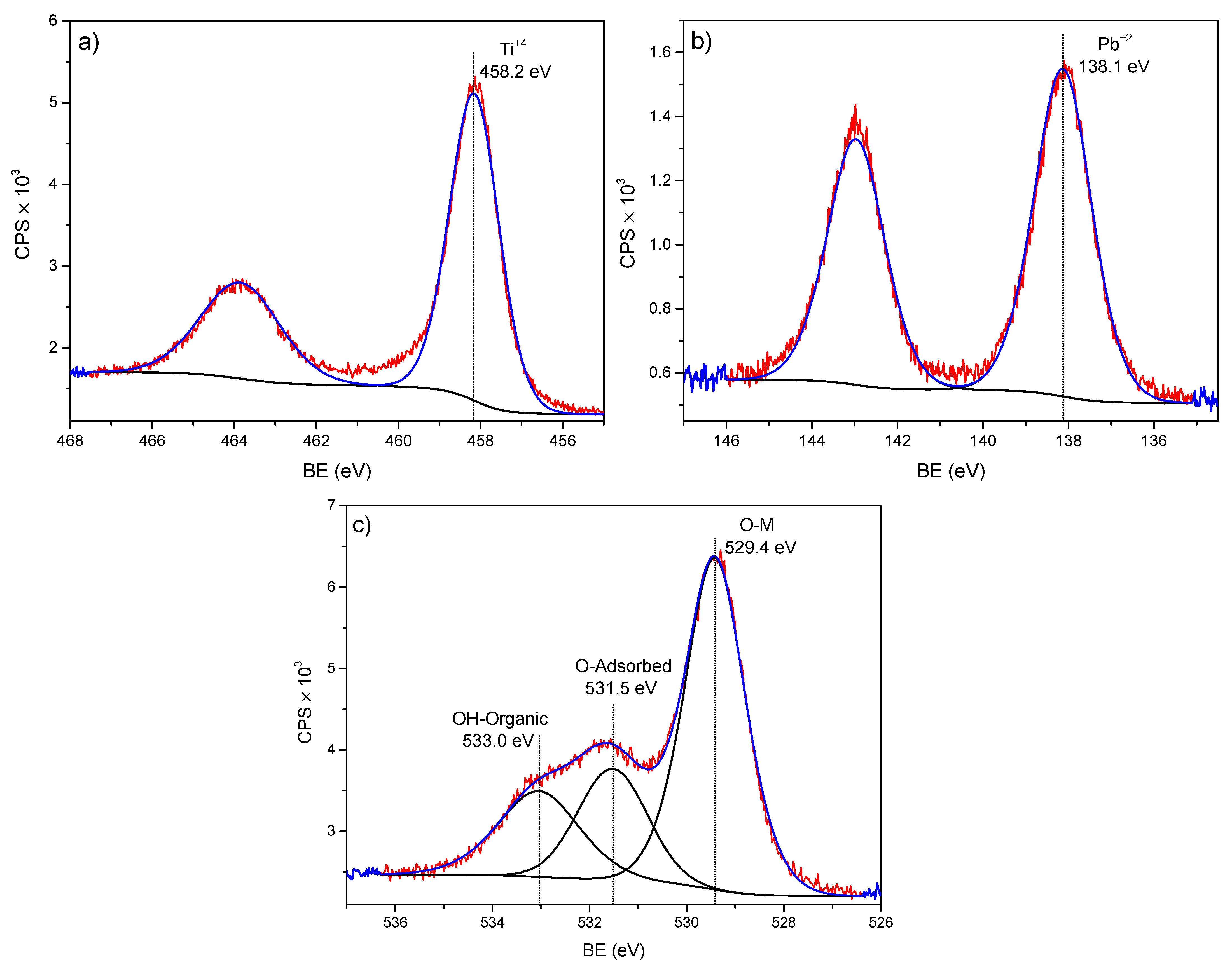
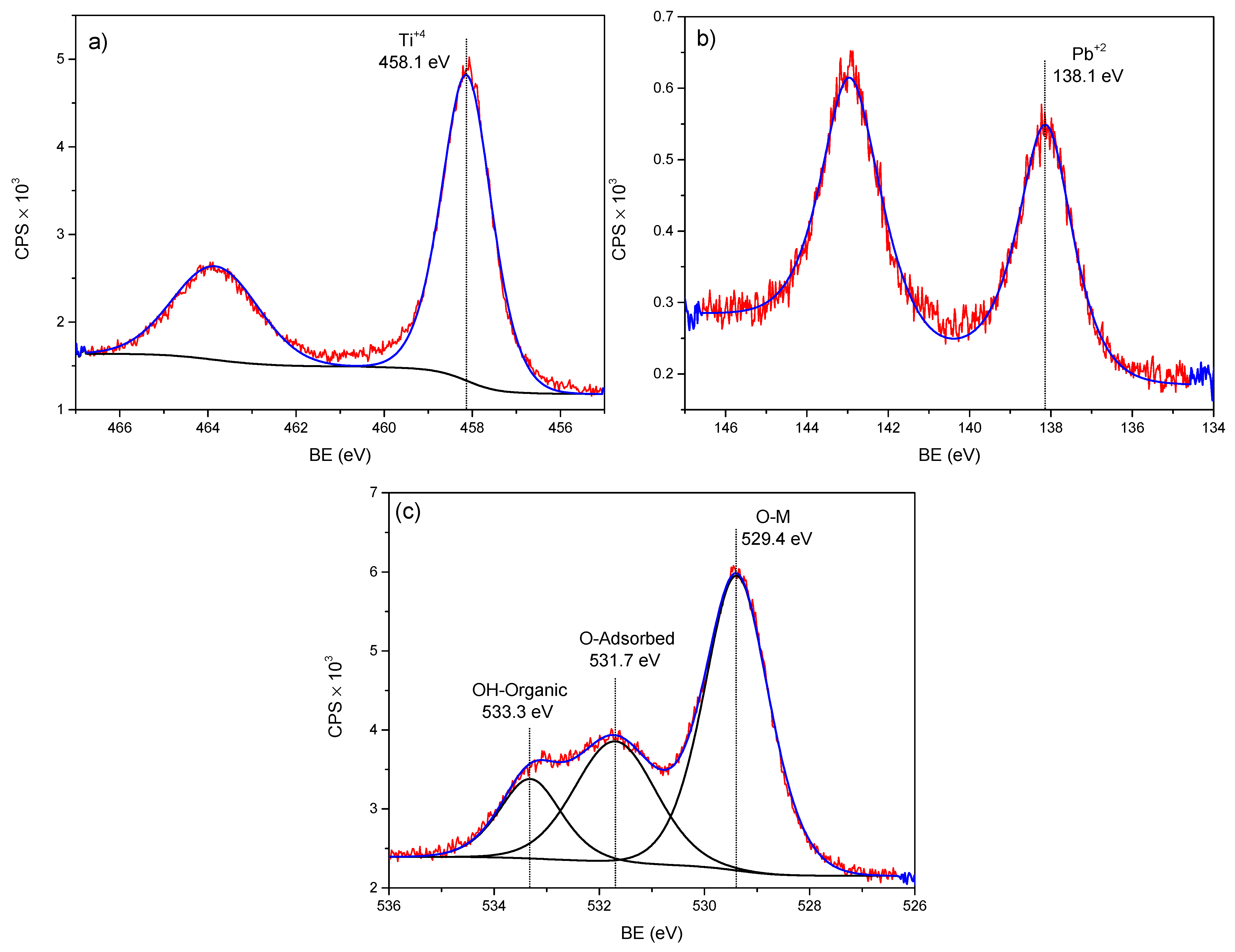
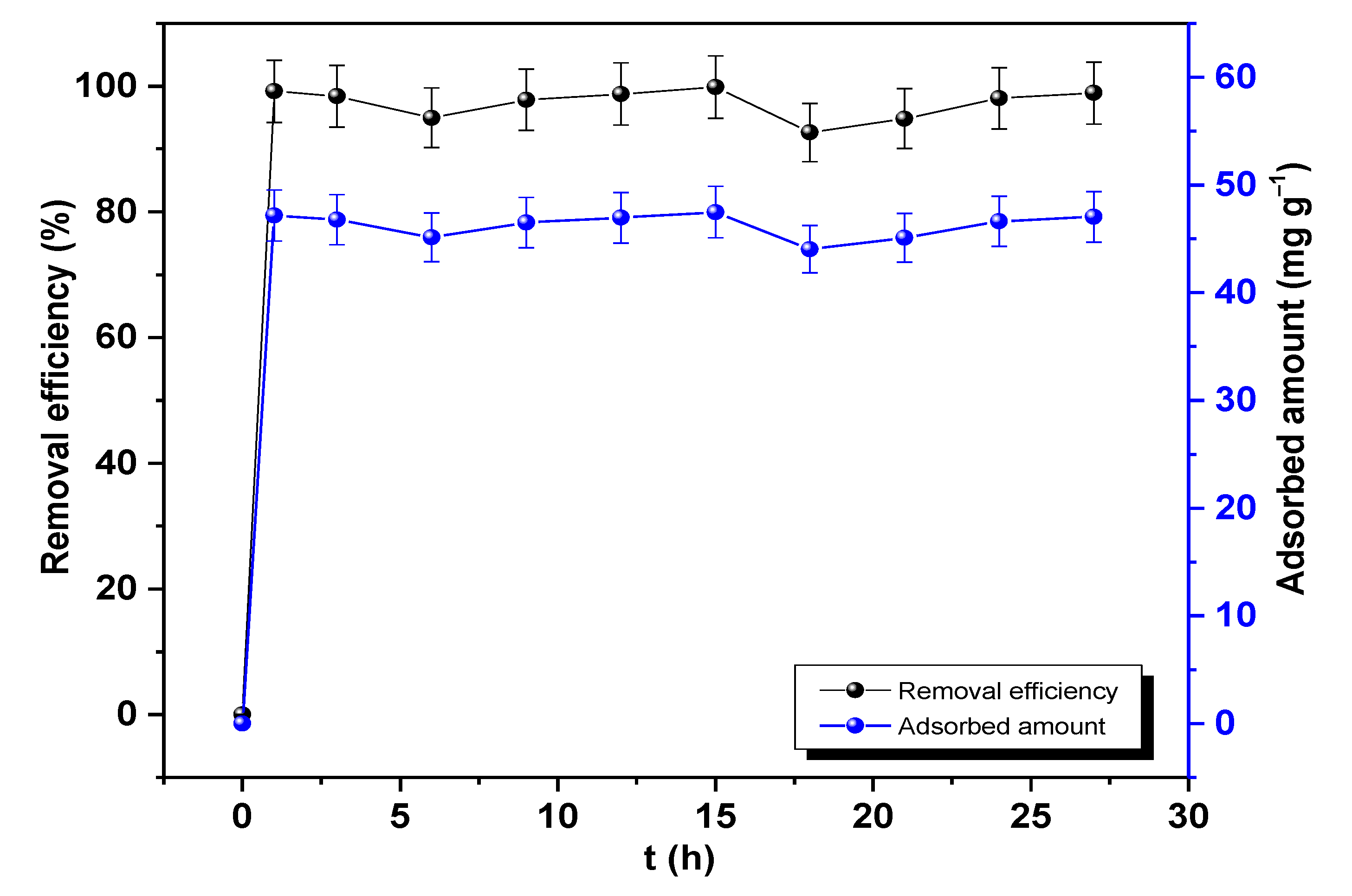
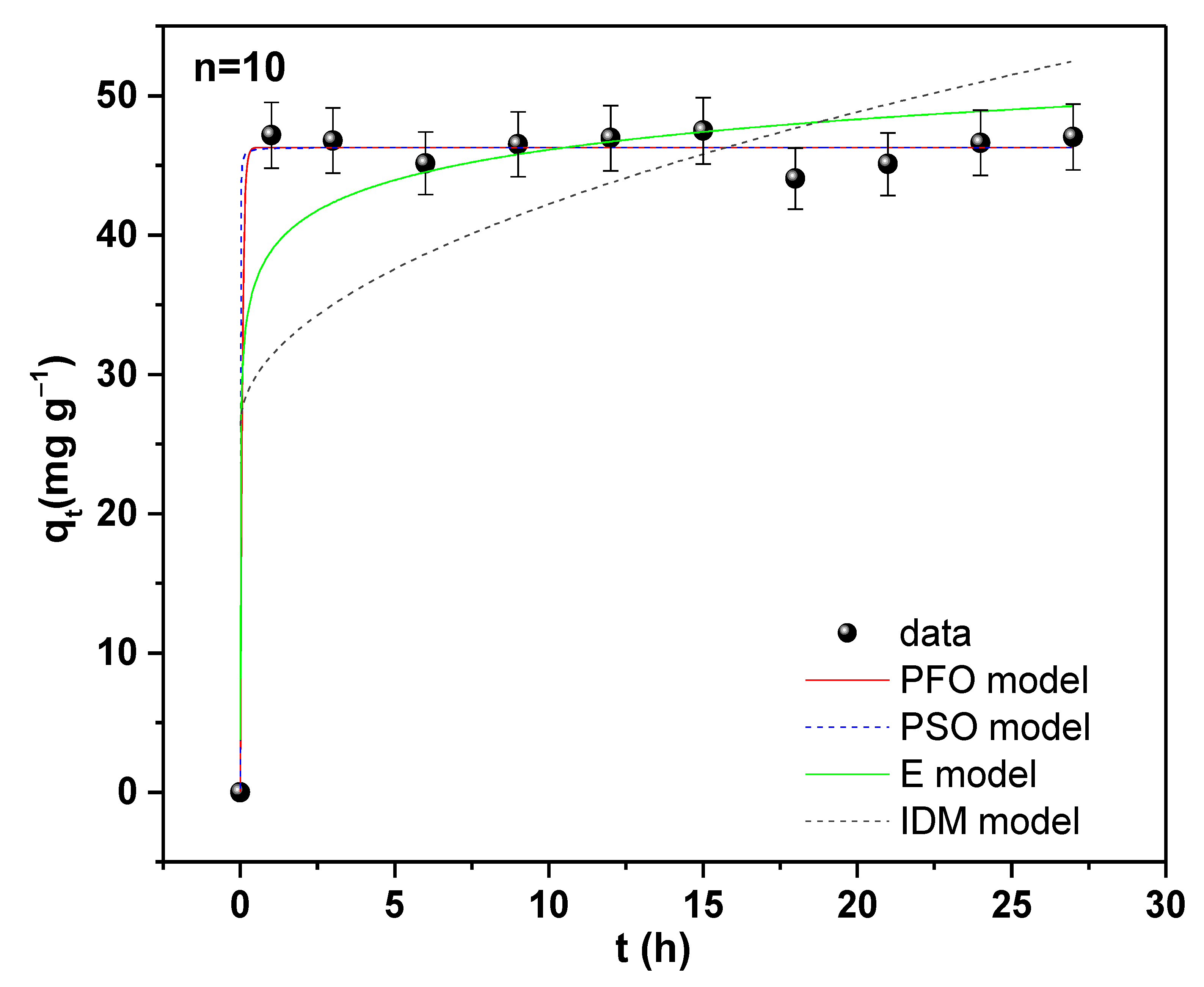
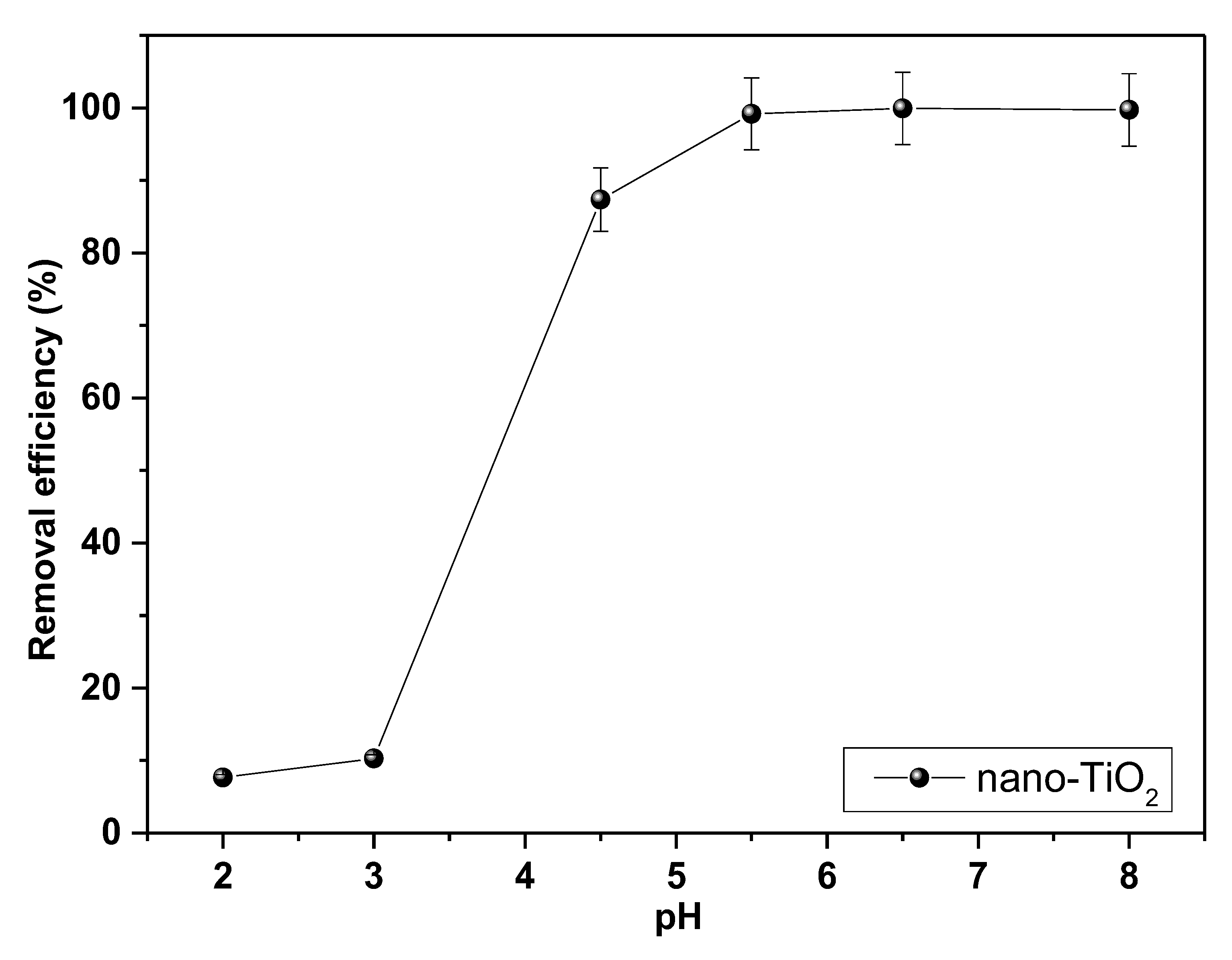
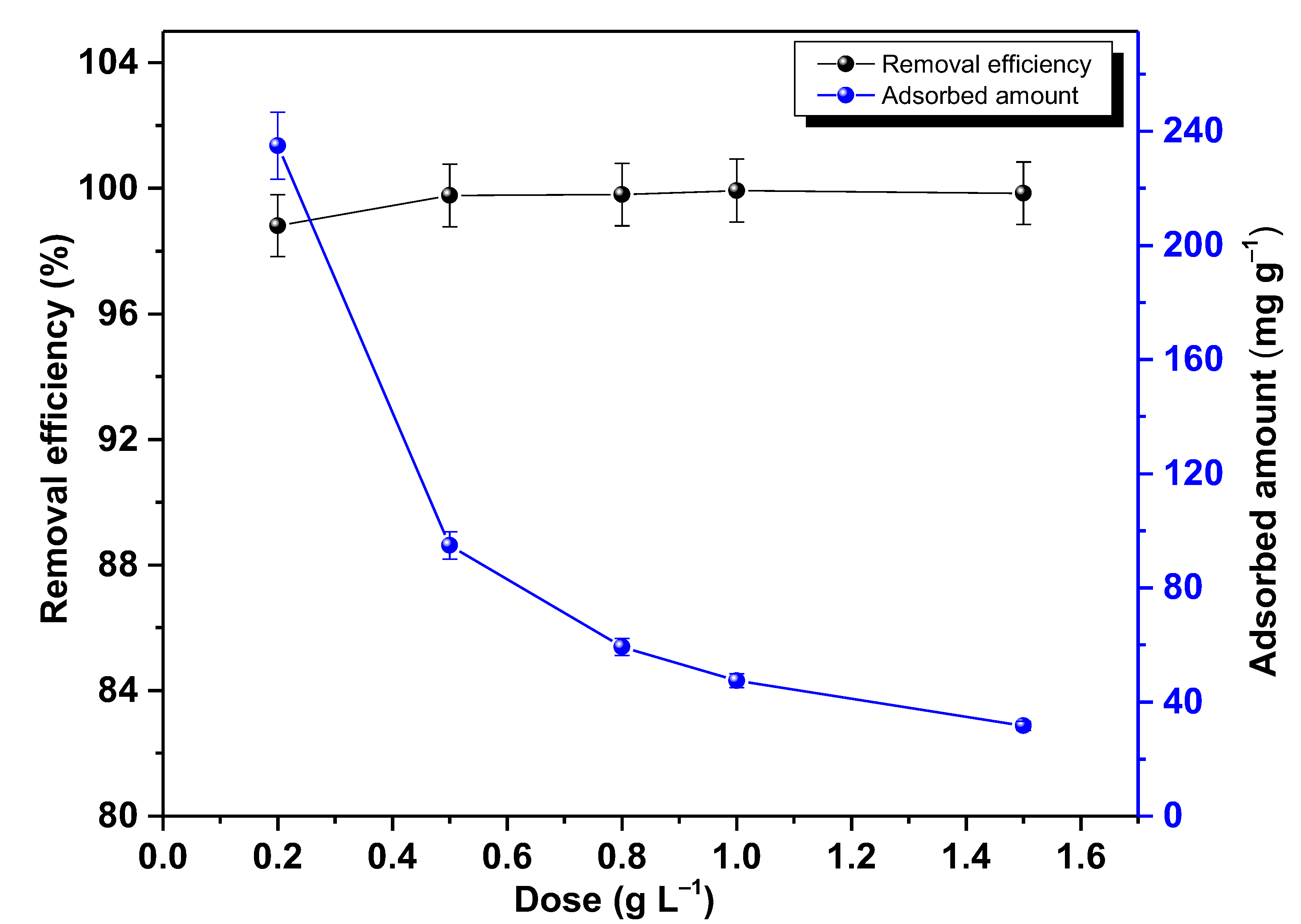
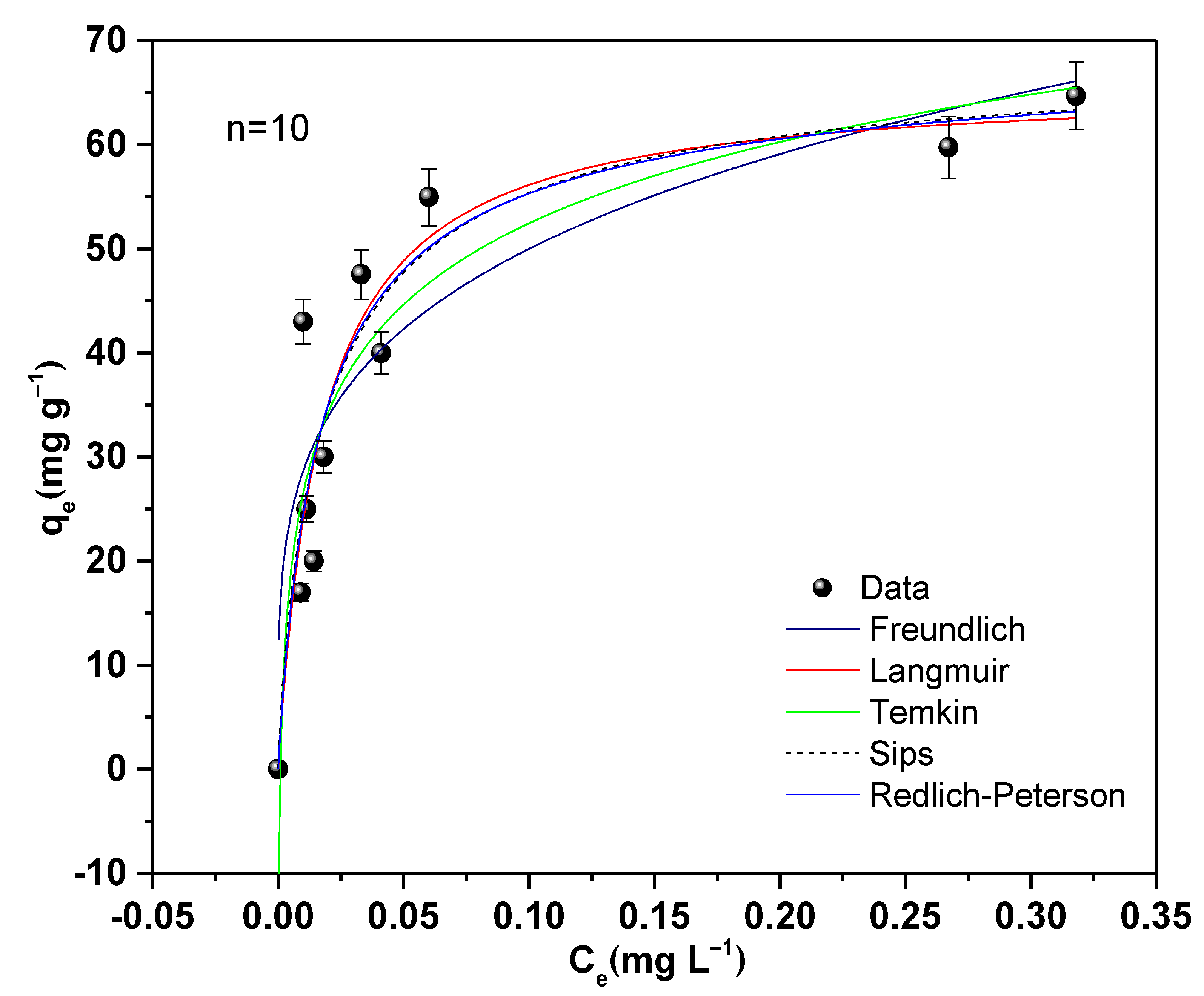

| Refined Parameters | TiO2-PbC1 Co = 47.54 mg L−1 | TiO2-PbC2 Co = 1.16 mg L−1 |
|---|---|---|
| 3.782 (9) | 3.798 (9) | |
| 3.782 (9) | 3.798 (9) | |
| 9.488 (3) | 9.527 (3) | |
| 90 | 90 | |
| 90 | 90 | |
| 90 | 90 | |
| 135.750 (6) | 137.441 (6) | |
| −0.077 (7) | 0.022 (4) | |
| 0.675 (8) | 0.972 (8) | |
| 0.650 (9) | 0.180 (9) | |
| 0.045 (6) | −0.127 (5) | |
| −0.958 (2) | −0.585 (2) | |
| −0.120 (9) | 0.554 (9) | |
| −0.368 (4) | −0.184 (3) | |
| −2.311 (2) | 0.952 (2) | |
| FWHM parameters | ||
| U | 4.464 | 4.342 |
| V | −2.569 | −2.549 |
| W | 0.907 | 0.919 |
| Average max strain | 108.48 (4) | 98.63 (3) |
| Average size (nm) | 9.9 (7) | 8.7 (5) |
| 4.52 | 4.54 | |
| 7.21 | 6.90 | |
| 7.70 | 7.38 | |
| χ2 | 2.90 | 2.63 |
| Sample | Ti (% wt) | O (% wt) | Pb (% wt) |
|---|---|---|---|
| TiO2-PbC1 | 47.7 ± 0.2 | 47.5 ± 0.2 | 4.8 ± 0.1 |
| TiO2-PbC2 | 57.8 ± 0.2 | 37.3 ± 0.2 | 4.8 ± 0.1 |
| Sample | Level | BE (eV) | at.% | Bond Type | Ref. |
|---|---|---|---|---|---|
| O 1s | 529.4 | 45.2 | O-Metal | [37] | |
| O 1s | 531.7 | 22.7 | O-adsorbed | [36] | |
| TiO2-Pb C2 | O 1s | 533.3 | 11.6 | OH-Organic | [38] |
| 1.16 mg L−1 | Ti 2p3/2 | 458.1 | 18.4 | Ti+4 (TiOx) | [35,36] |
| Pb 4f7/2 | 138.1 | 2.1 | Pb+2 | [36] | |
| O 1s | 529.4 | 46.6 | O-Metal | [37] | |
| TiO2-Pb C1 | O 1s | 531.5 | 17.4 | O-adsorbed | [36] |
| 47.54 mg L−1 | O 1s | 533.0 | 16.2 | OH-Organic | [38] |
| Ti 2p3/2 | 458.2 | 17.7 | Ti+4 (TiOx) | [35,36] | |
| Pb 4f7/2 | 138.1 | 2.1 | Pb+2 | [36] |
| PFO Model | PSO Model | E Model | |||
|---|---|---|---|---|---|
| qe exp (mg g−1) | 47.15 | qe (mg g−1) | 46.29 (4) | β (g mg−1) | 0.32 (4) |
| qe (mg g−1) | 46.28 (4) | k2 (g mg−1 h−1) | 12.74 (5) | α (mg h−1) | 43,223,954.34 (1) |
| k1 (h−1) | 16.29 | h (mg g−1 h−1) | 27,298.58 | ||
| R2 | 0.99 | 0.99 | 0.92 | ||
| RSS | 11.38 | 11.38 | 126.33 | ||
| BIC | 5.90 | 6.02 | 29.96 | ||
| IDM | |||||
| kp (mg g−1 h−0.5) | 5.04 (2) | ||||
| C1 (mg g−1) | 26.28 (8) | ||||
| R2 | 0.29 | ||||
| RSS | 1241.78 | ||||
| BIC | 52.82 | ||||
| Langmuir | Freundlich | Temkin | |||
|---|---|---|---|---|---|
| qe exp (mg g−1) | 47.5 | kF ((mg g−1)/(mg L−1)1/n) | 87.16 (1) | KT (L g−1) | 1049.45 (7) |
| qm (mg g−1) | 65.99 (6) | 1/n | 0.24 (5) | BT (J mol−1) | 219.85 (4) |
| kL (L mg−1) | 56.91 (2) | n | 3.45 (7) | ||
| R2 | 0.84 | 0.69 | 0.83 | ||
| RSS | 577.34 | 577.34 | 1260.61 | ||
| BIC | 48.36 | 77.25 | 56.95 | ||
| Sips | Redlich-Peterson | ||||
| (mg g−1) | 69.22 (1) | A (L g−1) | 4191.41 (3) | ||
| 50.71 (3) | B (L mg−1) | 60.75 (3) | |||
| ms | 0.85 (5) | 0.97 (2) | |||
| R2 | 0.82 | 0.82 | |||
| RSS | 570.48 | 575.87 | |||
| BIC | 48.23 | 50.73 | |||
Disclaimer/Publisher’s Note: The statements, opinions and data contained in all publications are solely those of the individual author(s) and contributor(s) and not of MDPI and/or the editor(s). MDPI and/or the editor(s) disclaim responsibility for any injury to people or property resulting from any ideas, methods, instructions or products referred to in the content. |
© 2023 by the authors. Licensee MDPI, Basel, Switzerland. This article is an open access article distributed under the terms and conditions of the Creative Commons Attribution (CC BY) license (https://creativecommons.org/licenses/by/4.0/).
Share and Cite
Vasquez-Caballero, M.A.; Canchanya-Huaman, Y.; Mayta-Armas, A.F.; Pomalaya-Velasco, J.; Checca-Huaman, N.-R.; Bendezú-Roca, Y.; Ramos-Guivar, J.A. Pb(II) Uptake from Polluted Irrigation Water Using Anatase TiO2 Nanoadsorbent. Molecules 2023, 28, 4596. https://doi.org/10.3390/molecules28124596
Vasquez-Caballero MA, Canchanya-Huaman Y, Mayta-Armas AF, Pomalaya-Velasco J, Checca-Huaman N-R, Bendezú-Roca Y, Ramos-Guivar JA. Pb(II) Uptake from Polluted Irrigation Water Using Anatase TiO2 Nanoadsorbent. Molecules. 2023; 28(12):4596. https://doi.org/10.3390/molecules28124596
Chicago/Turabian StyleVasquez-Caballero, Miguel A., Yamerson Canchanya-Huaman, Angie F. Mayta-Armas, Jemina Pomalaya-Velasco, Noemi-Raquel Checca-Huaman, Yéssica Bendezú-Roca, and Juan A. Ramos-Guivar. 2023. "Pb(II) Uptake from Polluted Irrigation Water Using Anatase TiO2 Nanoadsorbent" Molecules 28, no. 12: 4596. https://doi.org/10.3390/molecules28124596
APA StyleVasquez-Caballero, M. A., Canchanya-Huaman, Y., Mayta-Armas, A. F., Pomalaya-Velasco, J., Checca-Huaman, N.-R., Bendezú-Roca, Y., & Ramos-Guivar, J. A. (2023). Pb(II) Uptake from Polluted Irrigation Water Using Anatase TiO2 Nanoadsorbent. Molecules, 28(12), 4596. https://doi.org/10.3390/molecules28124596









